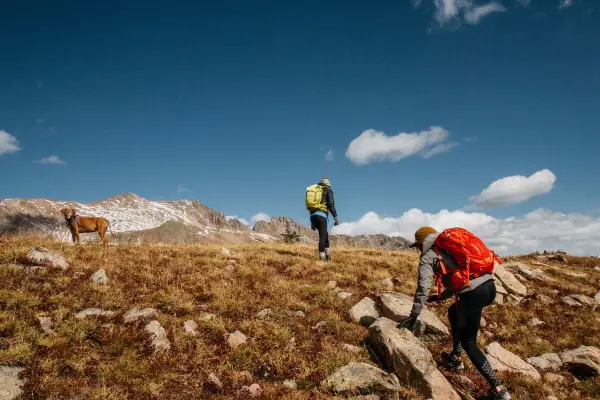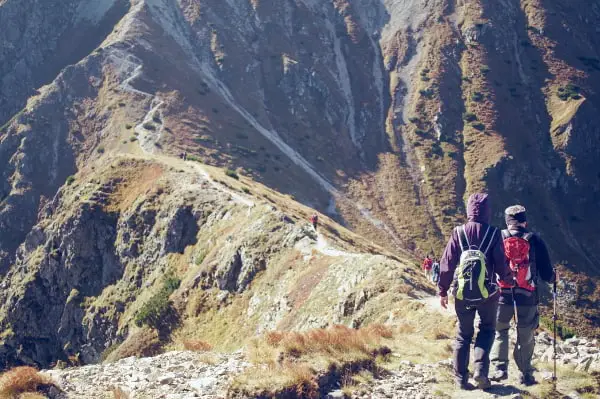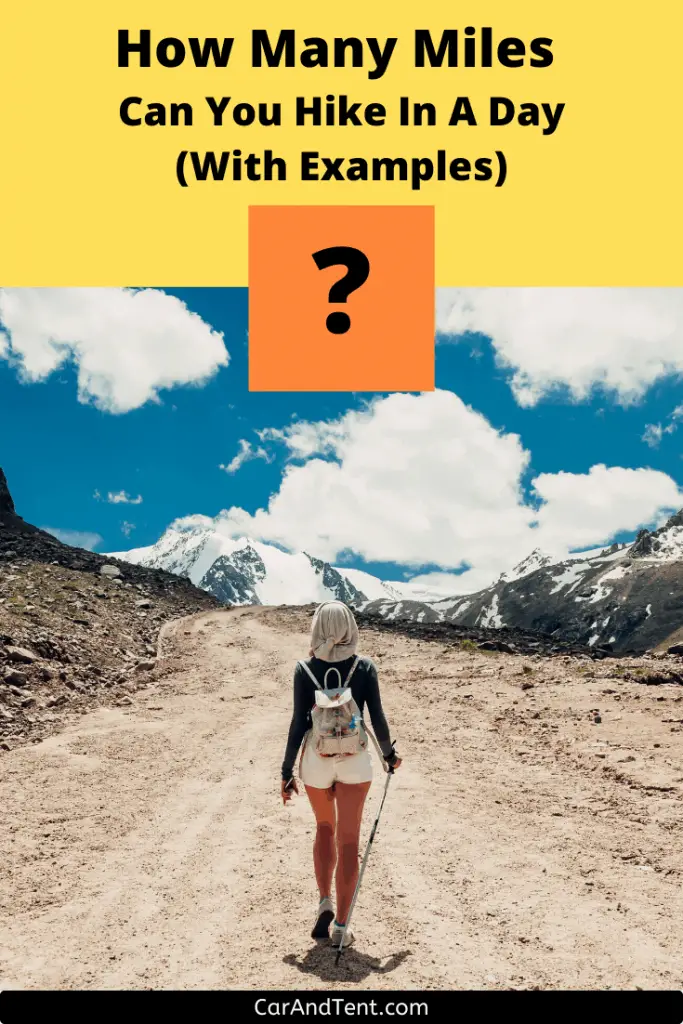
Whether you’re planning a day hike or an adventure on a long trail, it’s important to know how many miles you can hike in a day. Unfortunately, this isn’t quite as easy as you might think. Your walking and running speed aren’t a good indicator of your hiking speed and different types of hikes will be faster or slower depending on a large variety of factors.
So how many miles can you hike in a day? Expert hikers can hike over 50 miles a day while above-average hikers generally hike a bit over 24 miles per day. Beginner hikers should expect to hike much less. In fact, I’d recommend that a beginner plan for about 10 – 12 miles a day.
Here is some additional information to help you determine just how many miles you should plan to hike in a day.
Table of Contents
Some Data to Consider
Here are some examples of what’s possible. These are the people who have set records on some of the most popular trails in the United States.
Joe McConaughy and The AT
In 2017, Joe McConaughy set a record by doing an unsupported hike through the Appalachian trail in just 45 days. The trail is 2,190 miles long and he accidentally took a 3-mile detour, so this put him at about fifty miles a day. He did this with a 25-pound backpack. Of course, this was his average. On some days he’d do more than 50 miles and on other days, he’d do as little as 20 miles.
To accomplish this, McConaughy mostly had to run through the hike. In fact, he sometimes ran at night with a headlamp. He also had to take in an absurd amount of calories. Backpacker.com reports that he was consuming about 450 calories an hour.
Heather Anderson and The PCT
Back in 2013, Heather Anderson did an unsupported hike through the Pacific Crest Trail in just 60 days. The PCT is 2,655 miles, which means Anderson averaged over 44 miles a day. Remember, this was an unsupported hike too, so she was carrying food, water, and even camping supplies with her. In fact, she even brought a traditional, albeit lightweight tent along to sleep in.
Anderson didn’t just achieve the fastest known time on the Pacific Crest Trail either. At one point, she also held the fastest times on the CDT, (Continental Divide Trail), as well as the AT. She even completed all three trails back to back in less than a year. For the uninitiated, this is known as the “Triple Crown” among hiking enthusiasts.
Jeff Garmire and The AZT
Jeff Garmire hiked through some of the harshest terrains the United States has to offer at an average of over 50 miles a day. This allowed him to set the record on the 800 mile Arizona Trail.
Garmire also completed the Triple Crown as well as many other long-distance trails throughout the country. In fact, according to his website, he’s hiked well over 21,000 miles on these trails.
How This Relates to You
In most cases, this won’t really relate to you at all. These superhero hikers spent years upon years building up their strength and stamina. They trained hard and became expert hikers, backpackers, and in some cases marathon runners as well.
The numbers posted above are what is possible for athletic people who decide to devote large portions of their life to hiking and backpacking. If you don’t have the time or inclination to do this, you probably won’t ever achieve these numbers, and that’s OK.
Typical Hiking Times
The Appalachian Trail – According to AppalachianTrail.org, the Appalachian Trail typically takes between 5 – 7 months to complete. Split that down the middle at six months and you have an average of about 12 miles a day.
The Pacific Crest Trail – PCTA.org puts their average time to complete the trail at about 5 months. With a trail length of 2,650 miles, this puts the average miles per day at 18 miles a day.
The Arizona Trail – The AZT takes about 2 months to complete. At 800 miles long, this is an average of about 13 miles a day.
One thought to keep in mind when looking at these numbers is that most of these people were probably already avid hikers before they began these trails. Many people attempt to thru-hike these trails each year, but many never finish.
Other Numbers to Consider
If you’ve ever clicked the walk button on Google Maps, you’ll notice that they put the average walker at about 2.5 miles per hour. This number is pretty accurate for both walkers and hikers as well. The difference will come with the type of terrain that is being hiked through, the weather conditions, the weight of the hiker’s gear, and the hiker’s hiking experience and ability. My advice would be to expect to hike at a pace of about 2 miles per hour when moving through higher elevations and about 3 miles per hour while hiking through flat or downhill elevations.
At this point, you’re probably thinking, “shouldn’t I be able to hike faster when going downhill”?
The answer to this is usually a big “no”, as you’ll need to be more careful on the descent, so you won’t be able to move much quicker than if you were hiking on more even ground. In fact, in some cases, you may find yourself moving just as slowly downhill as you do uphill.

With these numbers, you could technically hike 8 hours a day and do about 24 miles each day. The problem with this number is that most people won’t be hiking 8 hours a day. Remember, you’ll need time to sleep, eat, and rest.
Also, you’ll be sleeping, eating, and resting a lot more than you usually do. On top of this, longer hikes will call for resupplies. You may need to take several hours out of your day each week just to pick up more food and water. Of course, this all changes if you’re just doing a day hike.
If you’re just on a day hike without any gear, you could probably add an additional .5 to 1 mile per hour to your hiking time. You won’t have any extra weight and you’ll be able to push yourself knowing that you won’t have to save any energy for the next day’s hike. However, if you plan on going on a day hike through a wilderness area, I’d highly recommend you don’t do it without at least a few pieces of gear. You can learn more about that on my post titled, “What to Bring on a Day Hike“.
How Long Will You Be Hiking
Another thought to keep in mind is the length of your hike. Hikers setting out on a two-day hike may be able to do many more miles per day than a person setting out on a 7-day hike. In fact, most people who do longer hikes will want to plan in some “zero-days”. These are the days where you won’t do any hiking at all. Instead, you’ll camp out, enjoy the scenery, and give your body a rest.
In my opinion, there isn’t any point in doing a long hike without these kinds of days. My thinking is, why hike all the way out into the wilderness if you aren’t going to stop and enjoy the scenery? If your intention is just to walk a lot of miles, you could just walk through your town each day.
Yet another consideration is that people who are relatively new to hiking often find that the speed at which they can hike often picks up throughout the trail. The reason for this is that they become physically and mentally stronger as each week passes by. This is why people on five-month-long hikes will often find that the last week of hiking is much easier than the first week of hiking.
How Many Miles Should You Plan to Do
The true answer to this is that if you have to ask the question, you probably shouldn’t plan any long hikes right now. Plan to do a shorter hike based on your walking ability and time yourself as you go along. Go on a variety of hikes that offer different elevations and different terrains and you’ll get a real sense for what you’re capable of.
This will also give you a chance to find out what gear works for you and what hiking footwear you like best. It will also give you some time to work on your navigation and wilderness skills as well. Taking the time to do this will make your longer hikes much safer and much more enjoyable.




